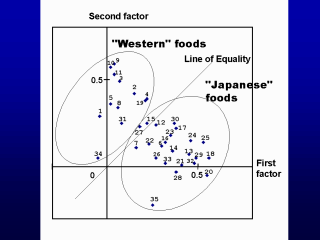| front |1 |2 |3 |4 |5 |6 |7 |8 |9 |10 |11 |12 |13 |14 |15 |16 |17 |18 |19 |20 |21 |22 |23 |24 |25 |26 |review |
 |
Factor loadings
for the second factor are plotted against the factor loadings for the first factor. Two
main clusters, labeled "Western" foods and "Japanese" foods can be
identified. "Western" foods: 1=beef, 2=pork, 3=ham and sausage, 4=chicken, 5=liver, 8=yogurt, 9=cheeses, 10=butter, 11=margarine, 19=tomatoes, 31=fruit juices, 34=coffee. "Japanese" foods: 6=eggs, 7=milk, 12=tempura and other fried food, 13=fried vegetables, 14=fish, 15=kamaboko (boiled fish paste), 16=salted and semi-dried fish, 17=green vegetables (e.g. spinach, garland chrysanthemum), 18=carrot and pumpkin, 20=cabbage and lettuce, 21=Chinese cabbage, 22=wild plants (e.g. warabi, zemmai), 23=fungi (e.g. enokidake, shiitake), 24=potatoes and sweet potatoes, 25=seaweed (e.g. nori, wakame, kombu), 26=tsukemono (pickled vegetables), 27= tsukudani (fish and shellfish boiled in sweetened soy source), 28=nimame (cooked beans), 29=tofu, 30=satsuma mandarins and oranges, 32=other fruits, 33=confectionery (e.g. manjuu, youkan, cakes), 35=green tea. |